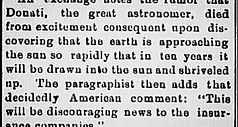



THE GLOBAL WARMING HOAX OF 1874
Giovanni Donati
Columbia Daily Phoenix, April 19, 1874
--Charitina Goebel
Sources:
1. http://www.museumofhoaxes.com/hoax/archive
/permalink/the_global_warming_hoax_of_1874
2. http://earthobservatory.nasa.gov/Features
/GlobalWarming /page3.php
“Research indicates that Europe will soon become a tropical zone. A few years later the entire world will be a sweltering inferno, unfit for life” (par. 1).
So wrote Giovanni Donati in the global warming hoax of 1874. Donati, an Italian astronomer, was said to have discovered these facts through years of taking “daily measurements of the distance from the earth to the sun” (par. 4).
He noticed the shift of the earth’s location in 1858 “when the first transatlantic
telegraph cable was laid” (par. 4). The earth continued to move closer to the
sun with each cable connection. When the scientist discovered the possible
end of the world he “trie[d] to alert the world’s government, but the politicians
ignore[d] him” (par. 1). Donati and his colleagues broke one of the cables to try
and stop the pull towards the sun but the cables were quickly repaired. Donati
realized he could not stop “the earth’s descent into the sun” (par. 6). The
scientist “die[d] of fright, agonizing over the fate of the human race” in
December of 1873 (par. 1).
This information was run in newspapers with the headline “A Scientific Sensation,” and presented as factual when in reality the story was fictional. The phony event was named “The Global Warming Hoax of 1874.” It first appeared in Kansas City Times who claimed to have gotten the information “from one J.B. Legendre” who said his information was from some “unnamed ‘American man of science’ living in Florence, Italy” (par. 3).
The story was printed “throughout the United States” but was not seen as a threat (par. 12). The newspapers did not take the story seriously because, apparently, “hoaxes appeared in late-nineteenth-century American newspapers all the time” (par. 16). People were used to seeing hoaxes in the news, especially “science-themed” ones, and “they were a particular favorite of bored reporters” (17).
Though the global warming bit was all a hoax there really was an Italian astronomer by the name of Giovanni Donati. That part was not a lie. He studied stars, comets, and the sun. Furthermore, he did die in December of 1873 but as “a result of cholera, not despair” (par. 9) The transatlantic telegraph cables were also real but were not pulling the earth into its fiery doom as stated in the hoax. This ruse of global warming was “one of the earliest (if not the earliest) fictional depictions of global warming triggered by mankind's technology — although it identified undersea cables rather than carbon emissions as the cause of the warming” (par. 20). By the time May rolled around everyone had forgotten about the impending destiny of the world.
Over one hundred years ago people were reading about this possible global warming crisis and though, in that case, the accounts were fictional, this day and age global warming is actually a reality. NASA compared past/ancient evidence of climate change, or paleoclimate, with today’s climate change rates and discovered that “as the Earth moved out of ice ages over the past million years, the global temperature rose a total of 4 to 7 degrees Celsius over about 5,000 years. In the past century alone, the temperature has climbed 0.7 degrees Celsius, roughly ten times faster than the average rate of ice-age-recovery warming” (par. 3). Basically, due to anthropogenic pollutants the climate change has become more rapid. Nasa believes that the rates of global warming will increase to 20 times the average rate and that the temperature will rise “between 2 and 6 degrees Celsius in the next century” (par. 4). So, though an ice age didn’t seem like a plausible occurrence one hundred years ago, the joke is on us one hundred years later.